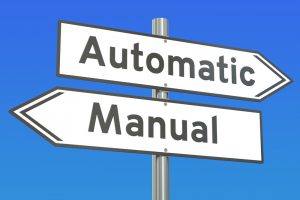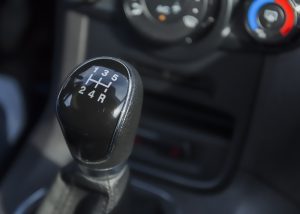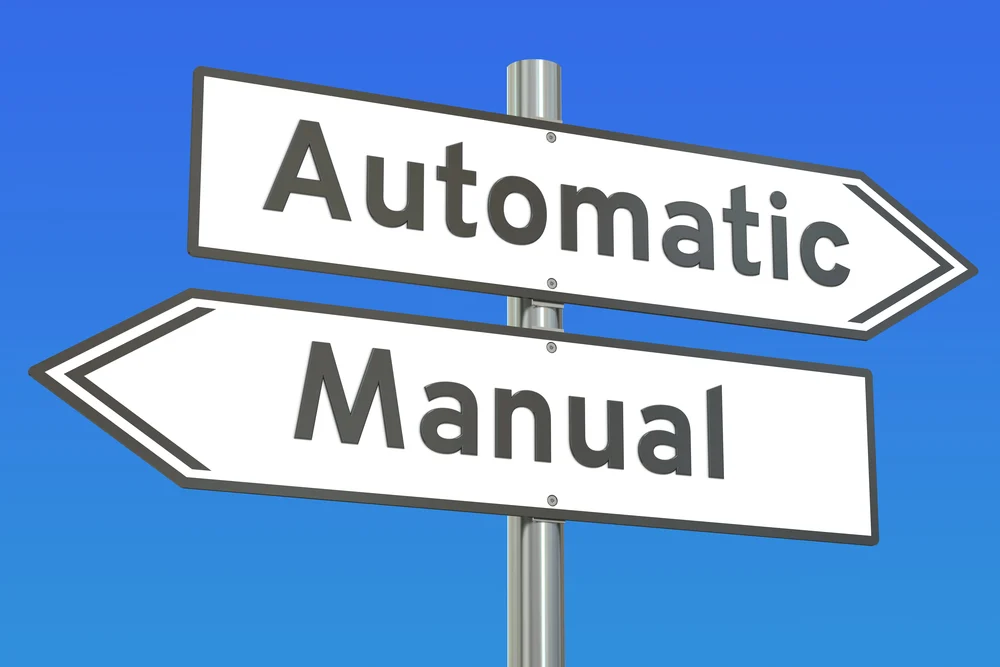Your car’s transmission is not only responsible for transferring power from the engine to the wheels but also for ensuring that you have a smooth ride. While there are a lot of similarities between automatic and manual transmissions, there are also plenty of differences. So, which one is better, automatic or manual? Let’s find out.

How Does the Transmission System Work?
The transmission is one of the most complicated components in your car and comprises a series of gears housed in a metal box. Since the engine can only operate within a limited range of speeds, the transmission has to slow down or speed up the revolutions from the engine. By changing gears, the transmission can adjust the power and torque delivered to the wheels when the vehicle is traveling at any given speed.
Different gears operate within a certain gear ratio and in lower gears, the available power and torque are increased for acceleration. However, in higher gears, the gear ratio provides less power and torque while allowing for a smoother drive when already at high speed. Automatic and manual transmissions work in almost the same way but they do have different components and come with different pros and cons.
Read More: What to Do When Your Car Overheats
Now that Malaysia allows one to hold a license for automatic transmission cars only, the question has become even more relevant – which one is better, a manual or an automatic car? There is no right or wrong when it comes to this question. Before going deeper into that, let’s discuss how these gears work in a car.
Manual Transmission
In a manual transmission, you use the gear lever to shift gears as you accelerate and decelerate. The gear lever is located on the center console and is linked to the transmission. Besides the gear lever, a manual car also has a clutch pedal which is located to the left of the brake pedal.
Pressing on the clutch pedal disengages the clutch that connects the engine and transmission, allowing you to change gears. After you change gears with the gear lever, letting go of the clutch pedal reengages the clutch which reconnects the engine to the transmission. This allows power to be sent through the transmission to the wheels.
Automatic Transmission
An automatic transmission works the same as a manual transmission, except that it changes gears automatically when you drive. Instead of the conventional mechanical clutch, an automatic gearbox uses automatic transmission fluid (ATF) inside of a torque converter to connect the engine to the transmission.
The ATF is used to lock and unlock the planetary gear set which is responsible for setting up the correct gear ratios. Besides applying pressure in the transmission to change the gears, the ATF is also responsible for cooling and lubricating the automatic transmission system.
Read More: Is Your Car Jerking? Here Are the Possible Causes
Continuously Variable Transmission CVT)
A CVT is a type of automatic transmission that does not have individual gears but instead uses a belt or chain attached to an engine pulley and a transmission pulley. Depending on the engine speed, a computer will adjust the size of the pulleys relative to each other.
When you’re accelerating and need more torque, the transmission pulley becomes larger than the engine pulley, so the transmission can convert the high engine rpm to more power and torque. As the vehicle speed increases, the engine pulley gets larger than the transmission pulley allowing for a smoother drive and better fuel economy at higher speeds.
Automatic Or Manual Transmission: Which Is Better?

Manual Transmission
The manual transmission has been around for decades before the automatic transmission became more common in passenger cars. However, with the rapid development of automatic transmissions, most passenger cars are only available as automatics. So what are the pros and cons of a manual transmission? First, let’s take a look at its benefits.
- Cheaper: On average, a manual car generally costs less than an automatic car of the same model. Other than the scheduled transmission fluid change, it also requires less maintenance and is generally cheaper to maintain and repair.
- Better fuel efficiency: Overall, manual transmissions are less complex, weigh less, and have more gears than automatic ones allowing for better fuel efficiency in the higher gears. The end result is that you get more kilometers out of the petrol you pump in than you would with an automatic. Manual transmissions have been known to save drivers between 5% and 15% on their fuel costs.
- Less likely to be stolen: With the increasing number of automatic transmissions on the road, many thieves would not have learned how to drive a manual. Additionally, manual cars are generally less sought after. If a thief decides to mark your manual car to steal it, there’s a good chance that the transmission would be able to change their mind.
- Better control: Automatic transmissions are designed to choose the best gear for any situation, but they tend to make a mistake on the side of caution, shifting to too high of a gear and wasting engine power. At the same time, they are built to respond to conditions as they are encountered, which doesn’t allow for drivers to either anticipate an oncoming condition or to purposely select a lower gear for an added boost of power. Manual transmissions give drivers greater control over the vehicle.
Read More: Here Are the Most Fuel-Efficient Cars in Malaysia

Some of the downsides of driving a manual transmission car include
- More difficult to drive: Learning to drive a manual car often takes more time as you have to learn how to operate the clutch pedal and shift gears when you drive. It can also be challenging to drive in a hilly area since you could easily stall your vehicle if you’re not careful.
- Heavy-traffic driving: Driving in heavy traffic conditions can be difficult due to constant stopping/starting and manual gear changes.
- Less Variety: Most cars manufactured now are automatic due to the fact that automatic cars are easier to drive and have a better demand. For car models that do have a manual version, it also tends to be in a lower trim level which may lack certain features, making it an even less appealing option.
Automatic Transmission
Automatic cars have practically replaced manual cars, especially among regular drivers. After all, automatic cars are easier to master and cause less fatigue in stop-and-go traffic. Here are some benefits of an automatic transmission.
- Easier to use: Most drivers take time to practise and learn to coordinate their limbs in order to control a manual transmission car. In an automatic car, the transmission changes the gears automatically. This makes an automatic car much easier for people to handle.
- No stalling on the hill: If you’re a less experienced driver, you may find that navigating steep inclines in a manual transmission is difficult, especially if you’re attempting to do so from a dead stop. Automatic transmissions take care of this issue, enabling your car to run without stalling on the hill.
- Easier during heavy traffic: More work goes into accelerating, decelerating, and stopping a manual transmission car. Since you need to constantly manipulate the clutch pedal in heavy traffic, your legs can get fatigued when you drive during rush hour. Automatic transmissions allow the driver to move through heavy traffic without having to do more than push a single pedal.
Some of the downsides of driving an automatic transmission car include
- Expensive: A new automatic car is generally more expensive than a manual car and the upkeep can be quite costly as automatic transmissions are more complex with a variety of working parts.
- Not as fuel-efficient: In the past, automatic cars tend to consume significantly more fuel than their manual counterparts. However, with advances in technology, modern automatic cars are getting just as fuel-efficient as manual ones.
Read More: Tires: How to Tell a Quality Used Car from a Lousy One

Continuously Variable Transmission (CVT)
A car with a CVT offers a similar driving experience to one with a conventional automatic transmission but there are still some noticeable differences between the two. First, here are the benefits of a CVT.
- Fuel efficient: Since a CVT uses a pulley system to continuously adjust the gearing ratio, it’s able to keep the engine revving at lower revolutions per minute (rpm). This contributes to a better fuel consumption compared to both conventional automatic and manual transmissions.
- Smoother to drive: A CVT doesn’t “shift gears” in the conventional sense. Therefore, you get a smoother ride in a car with CVT.
- Easy to drive: A car with CVT is just as easy to drive as a conventional automatic car since you don’t need to shift gears while driving.
Next, here are the cons of driving a car with CVT.
- It may be noisier: Earlier iterations of the CVT tend to have more engine drone compared to other transmissions. Some drivers will also experience a “rubber band” effect under a sudden throttle input. This results in a delayed acceleration even when the engine revs higher.
- It is costly to repair: CVT gearboxes tend to be more expensive to repair and replace. However, by regularly servicing the transmission and replacing the CVT fluid on time, you can ensure that it runs for years without issues.
Read More: How Pre-owned Cars Are Refurbished at the CARSOME Certified Lab
Choose CARSOME for Peace of Mind
If you’re looking for a reliable, quality car, check out CARSOME. All CARSOME Certified cars are put through a 175-point inspection to rule out major accidents and flood damage. We also professionally refurbish our cars to give them safety beyond standards, complete comfort, and a refurbished aesthetic.
Additionally, each CARSOME Certified car includes
- Fixed prices with no hidden fees. Our prices already include the road tax, Puspakom inspection fee, ownership transfer fee, and loan application fee.
- A five-day money-back guarantee in case you change your mind.
- A one-year warranty to ensure further peace of mind.
So what are you waiting for? Visit CARSOME today to find the perfect car for you!
